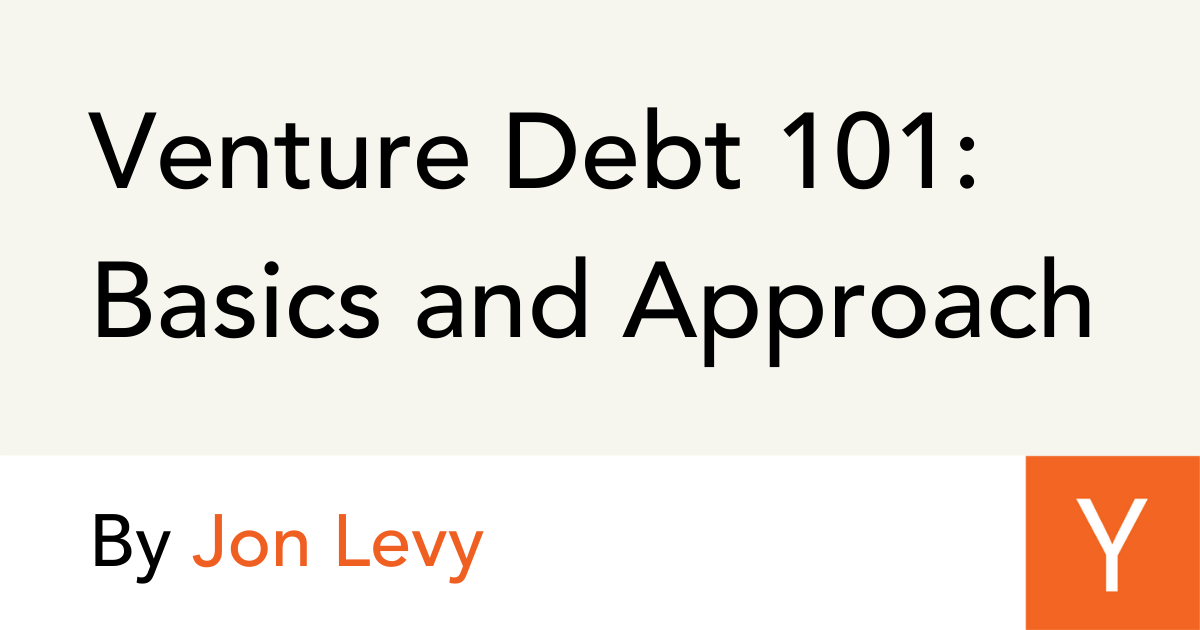Conclusion:
/nVenture debt clearly has many benefits — it offers startups a less dilutive way to inject capital into a healthy, growing business, a business that most traditional banks ignore today. At its best, venture debt is an effective complement to equity financing, and helps accelerate a company’s growth. But accessing venture debt is not without risks<a id=\"footnote2a\"><a href=https://www.ycombinator.com/"#footnote2\"><sup><b>2</b></sup></a></a>. Founders should be realistic and ask themselves whether they are taking on a burden that can be repaid. A company is best positioned to assume venture debt when it is confident in its ability to repay the loan, which will eliminate all associated risks.</p>\n<h3>GLOSSARY: BASIC TERMINOLOGY (for familiarity only; counsel needs to be hired):</h3>\n<p><u>Commitment</u>: What type of commitment is your venture debt investor making? How much money is being offered? When can your company access the money? Does the company need to “draw-down” over time? Can the company access all the capital at once?</p>\n<p><u>Term Loan/ Revolver</u>: Term loans are for a set time period (i.e. 3 years) and have a fixed payment schedule. The payment schedule can be “amortized” meaning that both the principal and interest is paid through periodic payments e.g. a mortgage; a “bullet” payment means the interest payment is made throughout and the principal is paid at the end of the term (aka the “maturity” date).</p>\n<p>Revolvers are like credit cards or a line of credit: a borrowing limit is set by the lender. Most venture lenders charge a “commitment fee” – the fee can be a flat fee or a fixed percentage of the commitment and is intended to compensate the lender for keeping open access to the money. Make sure to understand how much money is being paid on fees: venture lenders tend to nickel and dime companies with tiny fees.</p>\n<p><u>Interest Rate</u>: Interest rate is a crucial term and varies on a company’s ability to repay; the rate may vary from ~6-10%. Term sheets often express interest as “Prime rate plus x%”. Many lenders offer an interest only period prior to requiring repayment of principal.</p>\n<p><u>Warrants</u>: Warrants are another critical term and provide the lender with potential upside as a stockholder in a venture backed company. Warrants are typically a percentage of the commitment (i.e. 5% of $2mm). Most lenders ask for preferred stock based on a company’s last round, but an increasing amount of recent term sheets request a set percentage of common stock. Obviously, it is important to speak to multiple lenders when negotiating interest rates and warrant coverage.</p>\n<p><u>Prepayment Penalties</u>: Founders should make sure there are no charges for paying back their loan early (can be very useful if the market improves).</p>\n<p><u>Investor Abandonment</u>: A clause that allows the lender to demand repayment if a company’s investor doesn’t invest in the company’s future round.</p>\n<p><u>Negative Pledge on IP</u>: A clause that prevents a company from pledging its intellectual property to another party while the loan is outstanding. Sometimes lenders ask for a first-priority security interest on a company’s IP — this is a term companies should not accept.</p>\n<p><u>Field exams/ legal costs</u>: Beware of hidden fees! Look for clauses that allow the lender to conduct on site exams (at the company’s expense). Make sure to cap legal fees and do not pay the lender for documents that have been drafted a hundred times.</p>\n<p><u>Current Ratio/ Quick Ratio</u>: These financial terms measure a company’s liquidity and may impact how large a commitment a lender makes. The “current ratio” measures a company’s assets by dividing the company’s assets by the amount of liabilities. The “quick ratio” only includes the most liquid current assets that can be turned to cash quickly, and does not include inventory, supplies, etc. Venture debt lenders often use these ratios in covenants to monitor liquidity.</p>\n<p><u>Default Provisions</u>: Defaulting on a loan allows the lender to ask for its money back and can kill a company. There are different types of defaults in venture loan contracts: technical default (violating a covenant); monetary default (missing a payment); change in status default (legal judgment); and there are subjective defaults: “material adverse change” or “investor abandonment”. It is important to maintain a good relationship with your lender, especially if there is a subjective default provision that may be triggered. In these circumstances, a lender bank may choose to revise its debt, or make the more draconian decision to send the loan to its bank’s workout group.</p>\n<hr />\n<p><a id=\"footnote1\"><a href=https://www.ycombinator.com/"#footnote1a\"><sup><b>1</b></sup></a></a> Venture debt terms and concepts are very simple; the language may seem daunting because it is unfamiliar. The dynamic is similar to equity financings: it is disconcerting for founders when they first hear preferred stock financing terminology (e.g. liquidation preference, broad-based weighted average anti-dilution, right of first refusal and co-sale rights). But all YC founders quickly get up to speed and understand the meaning of these simple concepts. Venture debt terminology may seem unfamiliar, but also can be understood quickly.</p>\n<p><a id=\"footnote2\"><a href=https://www.ycombinator.com/"#footnote2a\"><sup><b>2</b></sup></a></a> I have not listed all the risks associated with venture debt. It is important to note that unlike equity, venture debt requires a startup to agree to financial “covenants” — e.g. a startup needs approval before incurring additional indebtedness, selling assets, etc.. More important, in a downside scenario, a venture lender often influences a company’s ultimate exit. That means if a company is running out of capital and has two options, one which employees prefer and one which is better for the bank, the company probably will have to choose the option that is better for the bank. These risks further highlight why founders need to be realistic about their ability to repay. To emphasize, founders should remember that venture debt is a debt that needs to be paid back.</p>\n<!--kg-card-end: html-->","comment_id":"1104897","feature_image":"/blog/content/images/2022/02/BlogTwitter-Image-Template-1--1-.png","featured":false,"visibility":"public","email_recipient_filter":"none","created_at":"2021-08-26T01:59:44.000-07:00","updated_at":"2022-02-03T16:34:50.000-08:00","published_at":"2021-08-26T01:59:44.000-07:00","custom_excerpt":"In this guide, YC Managing Director Jon Levy talks about venture debt. He covers what it is, walks through some of its benefits and risks, and gives advice on how to approach the process of taking on venture debt.","codeinjection_head":null,"codeinjection_foot":null,"custom_template":null,"canonical_url":null,"authors":[{"id":"61fe29e3c7139e0001a7109c","name":"Jon Levy","slug":"jon-levy","profile_image":"/blog/content/images/2022/02/jon.jpg","cover_image":null,"bio":"Jon is Managing Director, Partnerships at Y Combinator. He previously counseled public and private technology companies as an attorney for Wilson Sonsini Goodrich and Rosati.","website":null,"location":null,"facebook":null,"twitter":null,"meta_title":null,"meta_description":null,"url":"https://ghost.prod.ycinside.com/author/jon-levy/"}],"tags":[{"id":"61fe29efc7139e0001a71174","name":"Advice","slug":"advice","description":null,"feature_image":null,"visibility":"public","og_image":null,"og_title":null,"og_description":null,"twitter_image":null,"twitter_title":null,"twitter_description":null,"meta_title":null,"meta_description":null,"codeinjection_head":null,"codeinjection_foot":null,"canonical_url":null,"accent_color":null,"url":"https://ghost.prod.ycinside.com/tag/advice/"},{"id":"61fe29efc7139e0001a7116d","name":"Essay","slug":"essay","description":null,"feature_image":null,"visibility":"public","og_image":null,"og_title":null,"og_description":null,"twitter_image":null,"twitter_title":null,"twitter_description":null,"meta_title":null,"meta_description":null,"codeinjection_head":null,"codeinjection_foot":null,"canonical_url":null,"accent_color":null,"url":"https://ghost.prod.ycinside.com/tag/essay/"},{"id":"61fe29efc7139e0001a71170","name":"Startups","slug":"startups","description":null,"feature_image":null,"visibility":"public","og_image":null,"og_title":null,"og_description":null,"twitter_image":null,"twitter_title":null,"twitter_description":null,"meta_title":null,"meta_description":null,"codeinjection_head":null,"codeinjection_foot":null,"canonical_url":null,"accent_color":null,"url":"https://ghost.prod.ycinside.com/tag/startups/"}],"primary_author":{"id":"61fe29e3c7139e0001a7109c","name":"Jon Levy","slug":"jon-levy","profile_image":"https://ghost.prod.ycinside.com/content/images/2022/02/jon.jpg","cover_image":null,"bio":"Jon is Managing Director, Partnerships at Y Combinator. He previously counseled public and private technology companies as an attorney for Wilson Sonsini Goodrich and Rosati.","website":null,"location":null,"facebook":null,"twitter":null,"meta_title":null,"meta_description":null,"url":"https://ghost.prod.ycinside.com/author/jon-levy/"},"primary_tag":{"id":"61fe29efc7139e0001a71174","name":"Advice","slug":"advice","description":null,"feature_image":null,"visibility":"public","og_image":null,"og_title":null,"og_description":null,"twitter_image":null,"twitter_title":null,"twitter_description":null,"meta_title":null,"meta_description":null,"codeinjection_head":null,"codeinjection_foot":null,"canonical_url":null,"accent_color":null,"url":"https://ghost.prod.ycinside.com/tag/advice/"},"url":"https://ghost.prod.ycinside.com/venture-debt-101-basics-and-approach/","excerpt":"In this guide, YC Managing Director Jon Levy talks about venture debt. He covers what it is, walks through some of its benefits and risks, and gives advice on how to approach the process of taking on venture debt. He also highlights Brex’s newly launched venture debt offering. Brex is a YC portfolio company that provides an all-in-one finance solution to their customers. With Brex’s new offering, they have plans to make the venture debt process simple and transparent.","reading_time":8,"access":true,"og_image":null,"og_title":null,"og_description":null,"twitter_image":null,"twitter_title":null,"twitter_description":null,"meta_title":null,"meta_description":null,"email_subject":null,"frontmatter":null,"feature_image_alt":null,"feature_image_caption":null},{"id":"61fe29f1c7139e0001a719a8","uuid":"e32bea8e-8a01-45c4-a4ce-5aa53e477779","title":"Safes are not bad for entrepreneurs","slug":"safes-are-not-bad-for-entrepreneurs","html":"<!--kg-card-begin: html--><p>Pascal Levensohn and Andrew Krowne recently published an article: “<a href=https://www.ycombinator.com/"https://techcrunch.com/2017/07/08/why-safe-notes-are-not-safe-for-entrepreneurs//">Why Safe Notes are not safe for entrepreneurs</a>.” The authors were critical of the safe, describing it (as the click-bait title suggests), as bad for entrepreneurs. But the authors make an important point –- which was clarified by Levensohn in a follow-up post — with which we don’t disagree: both investors and entrepreneurs need to understand the way that convertible securities convert, and they need to understand dilution.</p>\n<p>The safe and its predecessor, the convertible note, have almost identical conversion features. So not understanding the effects of conversion is not a new problem that the safe specifically created. Rather, the ubiquity of using low-resolution fund-raising documents has created a larger universe of people (investors, founders, lawyers) grappling with conversion language.</p>\n<p>We agree that every party should understand how safes (and other convertible securities) convert. At Y Combinator, our CFO Kirsty Nathoo and other members of the finance team meet with founders each session to run through dilution examples and explain how safes convert. In addition, Y Combinator partner Geoff Ralston published an article and created a public tool to help any entrepreneur better understand dilution from safes: <a href=https://www.ycombinator.com/"https://angelcalc.com//">https://angelcalc.com/.
/nThe authors’ point may be that they believe priced equity rounds are preferable to using safes because all parties better understand how dilution works. Unfortunately, priced rounds are not as simple and fast a funding mechanism as safes (or other convertible securities). The transaction costs of a Series A round average $60,000 dollars, and the industry standard is that companies pay for BOTH their own legal counsel and the investor’s legal fees<sup id=\"footnoteid1\"><a href=https://www.ycombinator.com/"#footnote1\">1</a></sup>. That standard practice is not safe for entrepreneurs. There are several other non-obvious pitfalls for founders when doing priced rounds (including potential loss of board control, the consequences of which may be even more poorly anticipated than dilution), and priced rounds take longer. We believe that, more often than not, the trade-offs make the safe a better choice for <em>early stage</em> startups.</p>\n<p><b id=\"footnote1\">1.</b> I would rather the authors argue for a simplified, standard equity process for equity rounds rather than take aim at the Safe. Fortunately, there are developing startups like <a href=https://www.ycombinator.com/"https://techcrunch.com/2017/06/15/justin-kan-atrium-lts-funding//">Justin Kan’s Atrium</a> that are focused on solving the problem of complicated equity rounds.</p>\n<!--kg-card-end: html-->","comment_id":"1099868","feature_image":null,"featured":false,"visibility":"public","email_recipient_filter":"none","created_at":"2017-07-11T03:30:44.000-07:00","updated_at":"2021-10-20T13:01:36.000-07:00","published_at":"2017-07-11T03:30:44.000-07:00","custom_excerpt":null,"codeinjection_head":null,"codeinjection_foot":null,"custom_template":null,"canonical_url":null,"authors":[{"id":"61fe29e3c7139e0001a7109c","name":"Jon Levy","slug":"jon-levy","profile_image":"/blog/content/images/2022/02/jon.jpg","cover_image":null,"bio":"Jon is Managing Director, Partnerships at Y Combinator. He previously counseled public and private technology companies as an attorney for Wilson Sonsini Goodrich and Rosati.","website":null,"location":null,"facebook":null,"twitter":null,"meta_title":null,"meta_description":null,"url":"https://ghost.prod.ycinside.com/author/jon-levy/"}],"tags":[{"id":"61fe29efc7139e0001a71174","name":"Advice","slug":"advice","description":null,"feature_image":null,"visibility":"public","og_image":null,"og_title":null,"og_description":null,"twitter_image":null,"twitter_title":null,"twitter_description":null,"meta_title":null,"meta_description":null,"codeinjection_head":null,"codeinjection_foot":null,"canonical_url":null,"accent_color":null,"url":"https://ghost.prod.ycinside.com/tag/advice/"}],"primary_author":{"id":"61fe29e3c7139e0001a7109c","name":"Jon Levy","slug":"jon-levy","profile_image":"https://ghost.prod.ycinside.com/content/images/2022/02/jon.jpg","cover_image":null,"bio":"Jon is Managing Director, Partnerships at Y Combinator. He previously counseled public and private technology companies as an attorney for Wilson Sonsini Goodrich and Rosati.","website":null,"location":null,"facebook":null,"twitter":null,"meta_title":null,"meta_description":null,"url":"https://ghost.prod.ycinside.com/author/jon-levy/"},"primary_tag":{"id":"61fe29efc7139e0001a71174","name":"Advice","slug":"advice","description":null,"feature_image":null,"visibility":"public","og_image":null,"og_title":null,"og_description":null,"twitter_image":null,"twitter_title":null,"twitter_description":null,"meta_title":null,"meta_description":null,"codeinjection_head":null,"codeinjection_foot":null,"canonical_url":null,"accent_color":null,"url":"https://ghost.prod.ycinside.com/tag/advice/"},"url":"https://ghost.prod.ycinside.com/safes-are-not-bad-for-entrepreneurs/","excerpt":"Pascal Levensohn and Andrew Krowne recently published an article: “Why Safe Notes are not safe for entrepreneurs.” The authors were critical of the safe, describing it (as the click-bait title suggests), as bad for entrepreneurs. But the authors make an important point –- which was clarified by Levensohn in a follow-up post — with which we don’t disagree: both investors and entrepreneurs need to understand the way that convertible securities convert, and they need to understand dilution.","reading_time":1,"access":true,"og_image":null,"og_title":null,"og_description":null,"twitter_image":null,"twitter_title":null,"twitter_description":null,"meta_title":null,"meta_description":null,"email_subject":null,"frontmatter":null,"feature_image_alt":null,"feature_image_caption":null}],"filter":"By Jon Levy","featured":null,"pagination":{"page":1,"limit":10,"pages":1,"total":2,"next":null,"prev":null}},"url":"/blog/author/jon-levy","version":"aa5cc48c512ec693ec60765a0397dfe59cf5da82","encryptHistory":false,"clearHistory":false,"rails_context":{"railsEnv":"production","inMailer":false,"i18nLocale":"en","i18nDefaultLocale":"en","href":"https://www.ycombinator.com/blog/author/jon-levy","location":"/blog/author/jon-levy","scheme":"https","host":"www.ycombinator.com","port":null,"pathname":"/blog/author/jon-levy","search":null,"httpAcceptLanguage":"en, *","applyBatchLong":"Summer 2025","applyBatchShort":"S2025","applyDeadlineShort":"May 13","ycdcRetroMode":true,"currentUser":null,"serverSide":true},"id":"ycdc_new/pages/BlogList-react-component-8c46b910-45c9-4d3b-b994-50d7c375d077","server_side":true}" data-reactroot="">

